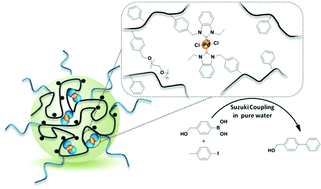当前位置:
X-MOL 学术
›
Polym. Chem.
›
论文详情
Our official English website, www.x-mol.net, welcomes your feedback! (Note: you will need to create a separate account there.)
Pd(ii)–NHC coordination-driven formation of water-soluble catalytically active single chain nanoparticles†
Polymer Chemistry ( IF 4.6 ) Pub Date : 2018-05-25 00:00:00 , DOI: 10.1039/c8py00326b Romain Lambert 1, 2, 3, 4, 5 , Anne-Laure Wirotius 1, 2, 3, 4, 5 , Sofiem Garmendia 1, 2, 3, 4, 5 , Pierre Berto 1, 2, 3, 4, 5 , Joan Vignolle 1, 2, 3, 4, 5 , Daniel Taton 1, 2, 3, 4, 5
Polymer Chemistry ( IF 4.6 ) Pub Date : 2018-05-25 00:00:00 , DOI: 10.1039/c8py00326b Romain Lambert 1, 2, 3, 4, 5 , Anne-Laure Wirotius 1, 2, 3, 4, 5 , Sofiem Garmendia 1, 2, 3, 4, 5 , Pierre Berto 1, 2, 3, 4, 5 , Joan Vignolle 1, 2, 3, 4, 5 , Daniel Taton 1, 2, 3, 4, 5
Affiliation

|
A well-defined linear statistical copolymer precursor, made of styrene, grafted poly(ethylene oxide) and benzimidazolium chloride units serving as N-heterocyclic carbene (NHC) ligand precursors, is designed by random RAFT copolymerization. Intramolecular coordination forming Pd(II)–NHC2 crosslinks yields single chain nanoparticles (SCNPs). The formation of SCNPs is achieved by the insertion of Pd(OAc)2 into diluted solution, which is monitored by combined analyses, including NMR, SEC, DLS and TEM. When used for the Suzuki coupling in water, the catalytic activity of these Pd(II)–NHC2-containing SCNPs is greatly improved relative to Pd(OAc)2 as a benchmark molecular catalyst. When compared to a molecular catalyst of Pd–NHC2-type, i.e. with a structure similar to that of the SCNP-supported catalytic units, the conversion to a reaction product is again higher, owing to a beneficial SCNP effect, although an increase in catalytic efficiency is not spectacular.
中文翻译:

Pd(ii)–NHC协调驱动的水溶性催化活性单链纳米颗粒的形成†
通过随机RAFT共聚设计了一种定义明确的线性统计共聚物前体,该共聚物由苯乙烯,接枝的聚环氧乙烷和苯并咪唑鎓氯化物单元(用作N-杂环卡宾(NHC)配体前体)制成。分子内配位形成Pd(II)–NHC 2交联产生单链纳米颗粒(SCNP)。SCNPs的形成是通过将Pd(OAc)2插入稀释溶液中来实现的,该溶液可以通过包括NMR,SEC,DLS和TEM在内的综合分析进行监测。当用于水中的Suzuki偶联时,与Pd(OAc)2相比,这些含Pd(II)–NHC 2的SCNPs的催化活性大大提高。作为基准分子催化剂。当与Pd–NHC 2型分子催化剂(即具有与SCNP负载的催化单元相似的结构)相比时,由于SCNP的有益作用,转化为反应产物的转化率再次更高,尽管增加了催化效率并不出色。
更新日期:2018-05-25
中文翻译:

Pd(ii)–NHC协调驱动的水溶性催化活性单链纳米颗粒的形成†
通过随机RAFT共聚设计了一种定义明确的线性统计共聚物前体,该共聚物由苯乙烯,接枝的聚环氧乙烷和苯并咪唑鎓氯化物单元(用作N-杂环卡宾(NHC)配体前体)制成。分子内配位形成Pd(II)–NHC 2交联产生单链纳米颗粒(SCNP)。SCNPs的形成是通过将Pd(OAc)2插入稀释溶液中来实现的,该溶液可以通过包括NMR,SEC,DLS和TEM在内的综合分析进行监测。当用于水中的Suzuki偶联时,与Pd(OAc)2相比,这些含Pd(II)–NHC 2的SCNPs的催化活性大大提高。作为基准分子催化剂。当与Pd–NHC 2型分子催化剂(即具有与SCNP负载的催化单元相似的结构)相比时,由于SCNP的有益作用,转化为反应产物的转化率再次更高,尽管增加了催化效率并不出色。



























 京公网安备 11010802027423号
京公网安备 11010802027423号